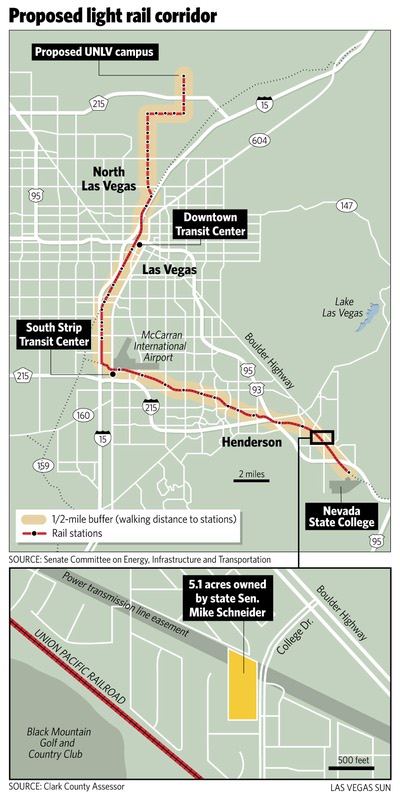Tuesday, April 14, 2009 | 2 a.m.
Reader poll
Sun archives
- Stimulus bill paves way for road projects (4-7-2009)
- Planning for light rail, despite its high cost (4-3-2009)
- Train-like bus line on track for winter opening (3-25-2009)
- Sponsor of bill is also a beneficiary: Ho hum (3-5-2009)
- Bill introduced to bring light rail system to Clark County (2-3-2009)
- Senator wants light rail system in Clark County (8-25-2008)
Plans for a system of streetcars gliding on rails across the Las Vegas Valley have faded again.
A light-rail bill pitched by state Sen. Mike Schneider died without reaching the Senate floor by a Friday deadline.
The Las Vegas Democrat’s bill would have required Clark County, Las Vegas, Henderson and North Las Vegas to buy rights-of-way for a fixed guideway corridor — either buses with dedicated lanes or, preferably to Schneider, light rail. But the mandate, some area leaders believe, was softened by four words embedded in the legislation: Those jurisdictions would have had to comply “to the extent practicable.”
So light rail remains conceptual, transportation officials said.
“At this point, we don’t have plans to move forward with light rail,” said Tracy Bower, spokeswoman for the Regional Transportation Commission of Southern Nevada. The agency has begun building a rapid bus system with some dedicated lanes.
Schneider blamed the bill’s death on a March 5 Las Vegas Sun story reporting that the senator, who owns five acres close to the southern end of the light-rail system, could benefit financially from the legislation.
Schneider said the Sun story deterred light-rail supporters from endorsing his bill. Light rail, he added, is not dead.
• • •
The cost of rehabilitating old roads and building new ones is increasing even though the federal gas tax to pay for such projects has remained the same since 1993 — 18.4 cents per gallon.
That trend is troubling to Susan Martinovich, director of the state Transportation Department.
And as hybrids and other higher-gas-mileage vehicles grow in popularity, gas tax revenues likely will slip further.
So Martinovich commissioned a $200,000 study in Washoe County of a “vehicle-miles-traveled” tax. That study could prompt a trial run in which some motorists are charged a tax based on miles they drive, not amount of gas purchased.
Martinovich is among a number of transportation leaders nationally examining such a system. Oregon conducted a field test in 2007, charging the nearly 300 participants 1.2 cents per mile rather than the 24-cent-per-gallon state gas tax. Transponders recorded the miles traveled.
“If it’s going to happen, I don’t want it to be forced upon us,” Martinovich said. “I want to see what works.”
Among questions to be addressed before such a system could be enacted: How would the mileage be recorded and reported to a government agency? Should drivers along congested corridors such as Interstate 15 be charged more than drivers on rural highways? Should larger vehicles pay more? Will drivers’ privacy be protected?
Paul Enos, president of the Nevada Truckers Association, worries that a vehicle-miles-traveled tax would create more bureaucracy: Instead of collecting gas tax from fewer than 200 distributors, he said, the proposed system would require auditing 2.2 million drivers and possibly gas stations.
• • •
Although no aircraft have struck high-tension power lines along Carey Avenue, just south of North Las Vegas Airport, the lines’ proximity to a flight corridor will likely prompt the Clark County Aviation Department to bury them between Simmons Street and a nearby Wal-Mart.
If the relocation project moves forward — and it could by year’s end — it would likely take 20 months to complete, airports spokesman Chris Jones said.
The project’s cost and funding have yet to be resolved. The county and NV Energy haven’t completed a facilities relocation agreement, so the project’s cost is unclear, Jones said. The county will probably get $6 million from the Federal Aviation Administration and would need to come up with a local contribution of 5 percent of the project’s cost, he said.
The U.S. Transportation Department announced that North Las Vegas Airport would get $7.8 million in stimulus dollars toward the project, but Jones clarified that the actual figure won’t be known until mid-June and that those dollars can’t be applied unless the county matches 5 percent of the FAA money.


Join the Discussion:
Check this out for a full explanation of our conversion to the LiveFyre commenting system and instructions on how to sign up for an account.
Full comments policy